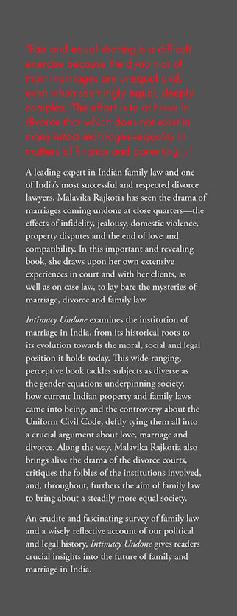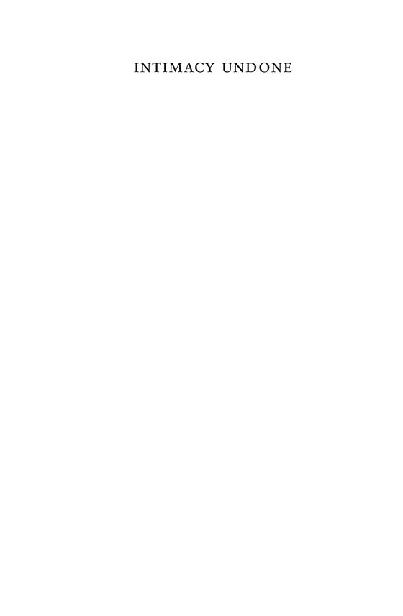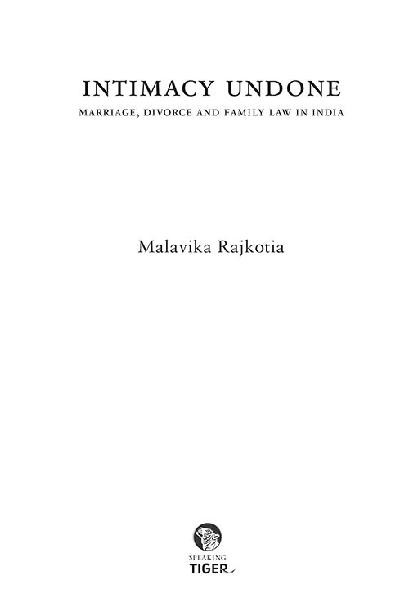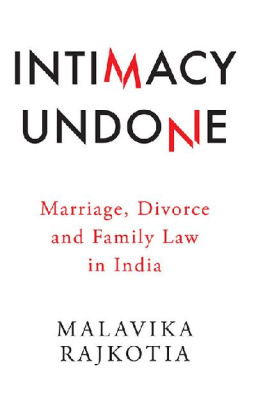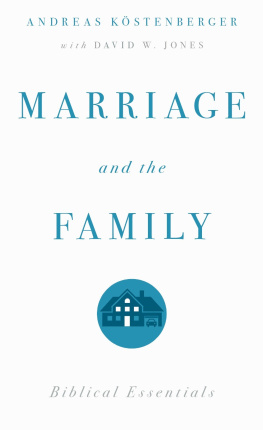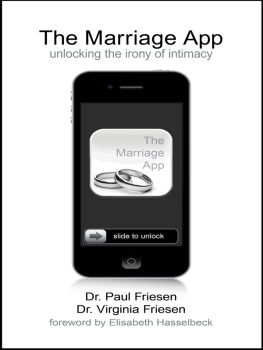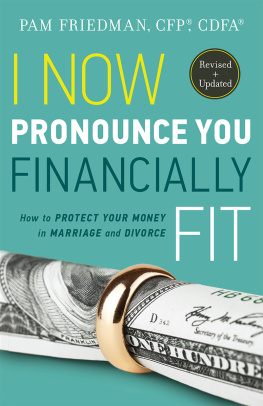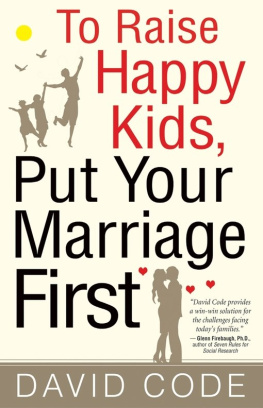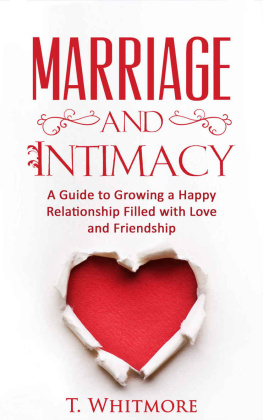To my parents:
my father, the Late Sardar Jitinder Singh who wanted the very first
copy off the press, and even now and always remains present with me
and
my mother, Gurdarshan Kaur.
I learned about family from them and the lessons were all good.
CONTENTS
INTRODUCTION
This book grew from a judicial barb that lodged in my heart. A judge in open court remarked to me that it is lawyers who are largely responsible for prolonging divorce litigation. My stung reaction was to write an open letter to the Chief Justice of the Delhi High Courtwhich I never sent because, to my surprise, it grew into this book.
~
The letter was in defence of family lawyers. The suggestion that lawyers are mainly responsible for obstructing settlements exposes a lack of understanding of the dynamics of the matrimonial conflict, which is much deeper and broader than what can be seen in court. A discussion of finance and parenting styles can get acrimonious even in intact marriages, but such disagreements are distorted to grotesque proportions in divorce situations. Since it is an emotive argument for the couple, a lawyer can never completely control a case and judges can never grasp the complete matter.
It is the litigants who decide on how far and how long they want to battle. We lawyers try to ensure that their decision is based on sound advice about the strengths and weaknesses of their cases, usually with the counsel that settling helps in achieving emotional closurethe value of which is never completely grasped, even by those who give such advice. Emotional closure can be achieved only at the pace of the suffering persons involved.
Divorce litigation is exhausting because the endeavour is to achieve in divorce that which does not exist in many intact marriages: equality in matters of finance and parenting. Fair and equal sharing is an emotionally fraught exercise, because the dynamics of most marriages are unequal. Even seemingly equal partnerships have an undertow of traditional gender equations, which essentially cause the dynamics to be unbalanced.
We lawyers risk seeming disruptive to the judges bench, as we struggle to obtain for our clients the closest semblance to the equality that the law promises, even while knowing that the outcome can never be entirely fair. Since the social reality is inherently unequal, we have to protect our clients from being intimidated or daunted by a legal system that may compel them to give up substantial rights.
Family lawyers are also always advised by courts to avoid getting personally involved. As officers of the court, we maintain a distance from the client. Due to that quality called empathy, however, we are vulnerable to translating our clients troubles into our own. Schopenhauer asked: How is it possible that suffering that is neither my own nor of my concern should immediately affect me as though it were my own, and with such force that it moves me to action? Every family lawyer suffers this to some extent and it need not always be bad, as long as it is checked by constant self-awareness about boundaries.
I have watched with a sense of pain as my clients hope for a speedy resolution dries up under the rigour of procedure. It is here that litigants draw strength and reassurance from the support of their partisan lawyer. I take providing that to be an integral part of my brief.
~
Every family unit is a microcosm of a certain part of society. Divorce litigation is an opportunity to study social change: it is like looking under the bonnet of a car when it has stalled. While you are fixing what is wrong in your particular car, you learn about cars generally. The legal history of family law is also the history of our collective movement towards civilized society, one with meaningful gender equality, fair distribution of material wealth and tender treatment of children.
Family law is treated as soft because, according to many people, it is more about common sense than hard-core law. It is to correct this perception that I begin the book with a chapter on the complicated history of family laws in India, as well as the careful advocacy required in establishing a case or defending it.
Divorce cannot be completely understood without an understanding of the history of marriage. The second and third chapters cover this, along with the changes that the institution of marriage has undergone, as moral values with regard to family, sex and gender have evolved.
~
I visualize the architecture of this book as a large pavilion in a forest of complex social realities. From the foundations, which are the history of marriage and family law, arises the super-structure of marriage and divorce law; custody law; laws on privacy within a marriage; concerns about the morality of adultery, pre-marital sex and sex within marriage; the ethics of litigation; the remedy of mediation and so on. Yet, the structure of the pavilion is dynamic and reflects social change.
The matter of children is interesting because even though they are a part of the structure of family law, they are also separate living beings, housed with their parents till they strike out on their own. Kahlil Gibran explains it beautifully in his poem, On Children:
Your children are not your children. They are the sons and daughters of Lifes longing for itself. They come through you but not from you. And though they are with you yet they belong not to you.
~
Then comes the matter of the integrity of the structure, which is bolstered with reference to our Constitution, from which emanate the concepts of gender equality and the current burning topic of the uniform civil code, vis--vis the right of each community to have a personal law in traction with the move towards gender equality. I have argued against imposing a uniform civil code, preferring the moderate route of reform within each community: otherwise, the topic tends to get hijacked by the majority into minority-bashing and brings to the fore identity politics, deflecting from the true purpose of achieving gender equality. We are currently in the midst of such a conflict on the validity of triple talaq in Islamic Law.
Family law has evolved alongside womens rights movements within and beyond each community. Since personal laws are rooted in patriarchy, a family law judge has to harmonize the principle of equality with the social reality that each community is different and change must not be perceived as a threat to its identity.
A characteristic of family law is its wide margins of discretion. Thus the emerging jurisprudence sometimes seems confused, because the exercise of judicial discretion will obviously be coloured by the socialization of each judge. Parliament is also responsible for the confusion, because it enacts various welfare legislations for populist reasons without careful debate, and the judiciary is left to fill the gaps in inept legislative drafting. It is this fluidity in family law that is misunderstood as the absence of positive law, requiring only logic and common sense.
The evolution of family law has also given an opportunity for thoughtful and active judges to espouse opinions that nudge the nation towards the constitutional ideals of gender equality, secularism and pluralism, even while negotiating territory mined with the raw nerves of identity and gender politics. The politics of change in India has revolved around customs that continue to survive even after being declared illegal. Family courts are the arena for this struggle of custom versus law. It requires a judiciary that furthers the law, but not too far away from social change as a ground reality. This the judges do by exhorting, even pontificating (not always unduly, we hope) while stating their opinions. We Indians are talkative and as Amartya Sen writes, argumentative. The downside to this is when judges expose their personal biases and prejudices and create precedents that spiral us away from, rather than further along, the road to a sharper delineation of rights.
